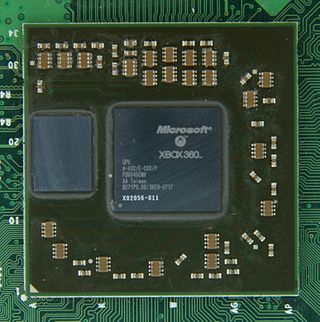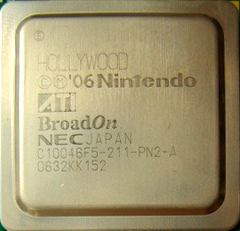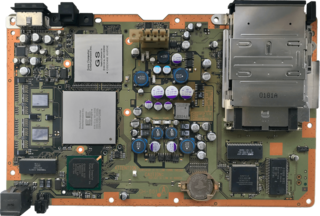The Xbox technical specifications describe the various components of the Xbox video game console.
Contents
- Central processing unit
- Memory
- Graphics processing unit
- Storage
- Audio
- Connectivity
- Physical specifications
- See also
- References

The Xbox technical specifications describe the various components of the Xbox video game console.







The GeForce 2 series (NV15) is the second generation of Nvidia's GeForce line of graphics processing units (GPUs). Introduced in 2000, it is the successor to the GeForce 256.

The GeForce 3 series (NV20) is the third generation of Nvidia's GeForce line of graphics processing units (GPUs). Introduced in February 2001, it advanced the GeForce architecture by adding programmable pixel and vertex shaders, multisample anti-aliasing and improved the overall efficiency of the rendering process.

The Voodoo 5 was the last and most powerful graphics card line that was released by 3dfx Interactive. All members of the family were based upon the VSA-100 graphics processor. Only the single-chip Voodoo 4 4500 and dual-chip Voodoo 5 5500 made it to market.

Savage was a product-line of PC graphics chipsets designed by S3.

The GeForce 7 series is the seventh generation of Nvidia's GeForce line of graphics processing units. This was the last series available on AGP cards.

The Xenos is a custom graphics processing unit (GPU) designed by ATI, used in the Xbox 360 video game console developed and produced for Microsoft. Developed under the codename "C1", it is in many ways related to the R520 architecture and therefore very similar to an ATI Radeon X1800 XT series of PC graphics cards as far as features and performance are concerned. However, the Xenos introduced new design ideas that were later adopted in the TeraScale microarchitecture, such as the unified shader architecture. The package contains two separate dies, the GPU and an eDRAM, featuring a total of 337 million transistors.

The Radeon R100 is the first generation of Radeon graphics chips from ATI Technologies. The line features 3D acceleration based upon Direct3D 7.0 and OpenGL 1.3, and all but the entry-level versions offloading host geometry calculations to a hardware transform and lighting (T&L) engine, a major improvement in features and performance compared to the preceding Rage design. The processors also include 2D GUI acceleration, video acceleration, and multiple display outputs. "R100" refers to the development codename of the initially released GPU of the generation. It is the basis for a variety of other succeeding products.

The RSX 'Reality Synthesizer' is a proprietary graphics processing unit (GPU) codeveloped by Nvidia and Sony for the PlayStation 3 game console. It is based on the Nvidia 7800GTX graphics processor and, according to Nvidia, is a G70/G71 hybrid architecture with some modifications. The RSX has separate vertex and pixel shader pipelines. The GPU makes use of 256 MB GDDR3 RAM clocked at 650 MHz with an effective transmission rate of 1.3 GHz and up to 224 MB of the 3.2 GHz XDR main memory via the CPU . Although it carries the majority of the graphics processing, the Cell Broadband Engine, the console's CPU, is also used complementarily for some graphics-related computational loads of the console.

Microsoft XCPU, codenamed Xenon, is a CPU used in the Xbox 360 game console, to be used with ATI's Xenos graphics chip.
Glaze3D was a family of graphics cards announced by BitBoys Oy on August 2, 1999, that would have produced substantially better performance than other consumer products available at the time. The family, which would have come in the Glaze3D 1200, Glaze3D 2400 and Glaze3D 4800 models, was supposed to offer full support for DirectX 7, OpenGL 1.2, AGP 4×, 4× anisotropic filtering, full-screen anti-aliasing and a host of other technologies not commonly seen at the time. The 1.5 million gate GPU would have been fabricated by Infineon on a 0.2 μm eDRAM process, later to be reduced to 0.17 μm with a minimum of 9 MB of embedded DRAM and 128 to 512 MB of external SDRAM. The maximum supported video resolution was 2048×1536 pixels.

The Hollywood graphics chip is the graphics processing unit (GPU) used in Nintendo's Wii video game console. It was designed by ATI, and was manufactured using the same 90 nm or 65 nm CMOS process as Broadway, the Wii's central processing unit. Very few official details about Hollywood were released to the public by Nintendo, ATI, or any other company involved in the Wii's development. The Hollywood GPU is reportedly based on the GameCube's Flipper GPU and is clocked 50% higher at 243 MHz, though these clock rates have never been officially confirmed.

The GeForce 9 series is the ninth generation of Nvidia's GeForce line of graphics processing units, the first of which was released on February 21, 2008. The products are based on an updated Tesla microarchitecture, adding PCI Express 2.0 support, improved color and z-compression, and built on a 65 nm process, later using 55 nm process to reduce power consumption and die size.
Tiled rendering is the process of subdividing a computer graphics image by a regular grid in optical space and rendering each section of the grid, or tile, separately. The advantage to this design is that the amount of memory and bandwidth is reduced compared to immediate mode rendering systems that draw the entire frame at once. This has made tile rendering systems particularly common for low-power handheld device use. Tiled rendering is sometimes known as a "sort middle" architecture, because it performs the sorting of the geometry in the middle of the graphics pipeline instead of near the end.
The Xbox 360 technical specifications describe the various components of the Xbox 360 video game console.

InfiniteReality refers to a 3D graphics hardware architecture and a family of graphics systems that implemented the aforementioned hardware architecture that was developed and manufactured by Silicon Graphics from 1996 to 2005. The InfiniteReality was positioned as Silicon Graphics' high-end visualization hardware for their MIPS/IRIX platform and was used exclusively in their Onyx family of visualization systems, which are sometimes referred to as "graphics supercomputers" or "visualization supercomputers". The InfiniteReality was marketed to and used by large organizations such as companies and universities that are involved in computer simulation, digital content creation, engineering and research.

The GeForce 700 series is a series of graphics processing units developed by Nvidia. While mainly a refresh of the Kepler microarchitecture, some cards use Fermi (GF) and later cards use Maxwell (GM). GeForce 700 series cards were first released in 2013, starting with the release of the GeForce GTX Titan on February 19, 2013, followed by the GeForce GTX 780 on May 23, 2013. The first mobile GeForce 700 series chips were released in April 2013.

The GeForce 900 series is a family of graphics processing units developed by Nvidia, succeeding the GeForce 700 series and serving as the high-end introduction to the Maxwell microarchitecture, named after James Clerk Maxwell. They are produced with TSMC's 28 nm process.
The AMD Jaguar Family 16h is a low-power microarchitecture designed by AMD. It is used in APUs succeeding the Bobcat Family microarchitecture in 2013 and being succeeded by AMD's Puma architecture in 2014. It is two-way superscalar and capable of out-of-order execution. It is used in AMD's Semi-Custom Business Unit as a design for custom processors and is used by AMD in four product families: Kabini aimed at notebooks and mini PCs, Temash aimed at tablets, Kyoto aimed at micro-servers, and the G-Series aimed at embedded applications. Both the PlayStation 4 and the Xbox One use SoCs based on the Jaguar microarchitecture, with more powerful GPUs than AMD sells in its own commercially available Jaguar APUs.

The PlayStation 2 technical specifications describe the various components of the PlayStation 2 (PS2) video game console.